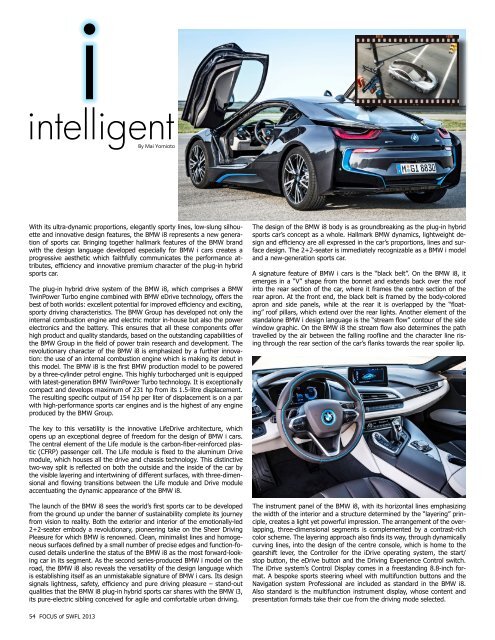FOCusof ARTIST
You also want an ePaper? Increase the reach of your titles
YUMPU automatically turns print PDFs into web optimized ePapers that Google loves.
i<br />
intelligent<br />
By Mai Yomioto<br />
With its ultra-dynamic proportions, elegantly sporty lines, low-slung silhouette<br />
and innovative design features, the BMW i8 represents a new generation<br />
of sports car. Bringing together hallmark features of the BMW brand<br />
with the design language developed especially for BMW i cars creates a<br />
progressive aesthetic which faithfully communicates the performance attributes,<br />
efficiency and innovative premium character of the plug-in hybrid<br />
sports car.<br />
The plug-in hybrid drive system of the BMW i8, which comprises a BMW<br />
TwinPower Turbo engine combined with BMW eDrive technology, offers the<br />
best of both worlds: excellent potential for improved efficiency and exciting,<br />
sporty driving characteristics. The BMW Group has developed not only the<br />
internal combustion engine and electric motor in-house but also the power<br />
electronics and the battery. This ensures that all these components offer<br />
high product and quality standards, based on the outstanding capabilities of<br />
the BMW Group in the field of power train research and development. The<br />
revolutionary character of the BMW i8 is emphasized by a further innovation:<br />
the use of an internal combustion engine which is making its debut in<br />
this model. The BMW i8 is the first BMW production model to be powered<br />
by a three-cylinder petrol engine. This highly turbocharged unit is equipped<br />
with latest-generation BMW TwinPower Turbo technology. It is exceptionally<br />
compact and develops maximum of 231 hp from its 1.5-litre displacement.<br />
The resulting specific output of 154 hp per liter of displacement is on a par<br />
with high-performance sports car engines and is the highest of any engine<br />
produced by the BMW Group.<br />
The design of the BMW i8 body is as groundbreaking as the plug-in hybrid<br />
sports car’s concept as a whole. Hallmark BMW dynamics, lightweight design<br />
and efficiency are all expressed in the car’s proportions, lines and surface<br />
design. The 2+2-seater is immediately recognizable as a BMW i model<br />
and a new-generation sports car.<br />
A signature feature of BMW i cars is the “black belt”. On the BMW i8, it<br />
emerges in a “V” shape from the bonnet and extends back over the roof<br />
into the rear section of the car, where it frames the centre section of the<br />
rear apron. At the front end, the black belt is framed by the body-colored<br />
apron and side panels, while at the rear it is overlapped by the “floating”<br />
roof pillars, which extend over the rear lights. Another element of the<br />
standalone BMW i design language is the “stream flow” contour of the side<br />
window graphic. On the BMW i8 the stream flow also determines the path<br />
travelled by the air between the falling roofline and the character line rising<br />
through the rear section of the car’s flanks towards the rear spoiler lip.<br />
The key to this versatility is the innovative LifeDrive architecture, which<br />
opens up an exceptional degree of freedom for the design of BMW i cars.<br />
The central element of the Life module is the carbon-fiber-reinforced plastic<br />
(CFRP) passenger cell. The Life module is fixed to the aluminum Drive<br />
module, which houses all the drive and chassis technology. This distinctive<br />
two-way split is reflected on both the outside and the inside of the car by<br />
the visible layering and intertwining of different surfaces, with three-dimensional<br />
and flowing transitions between the Life module and Drive module<br />
accentuating the dynamic appearance of the BMW i8.<br />
The launch of the BMW i8 sees the world’s first sports car to be developed<br />
from the ground up under the banner of sustainability complete its journey<br />
from vision to reality. Both the exterior and interior of the emotionally-led<br />
2+2-seater embody a revolutionary, pioneering take on the Sheer Driving<br />
Pleasure for which BMW is renowned. Clean, minimalist lines and homogeneous<br />
surfaces defined by a small number of precise edges and function-focused<br />
details underline the status of the BMW i8 as the most forward-looking<br />
car in its segment. As the second series-produced BMW i model on the<br />
road, the BMW i8 also reveals the versatility of the design language which<br />
is establishing itself as an unmistakable signature of BMW i cars. Its design<br />
signals lightness, safety, efficiency and pure driving pleasure – stand-out<br />
qualities that the BMW i8 plug-in hybrid sports car shares with the BMW i3,<br />
its pure-electric sibling conceived for agile and comfortable urban driving.<br />
The instrument panel of the BMW i8, with its horizontal lines emphasizing<br />
the width of the interior and a structure determined by the “layering” principle,<br />
creates a light yet powerful impression. The arrangement of the overlapping,<br />
three-dimensional segments is complemented by a contrast-rich<br />
color scheme. The layering approach also finds its way, through dynamically<br />
curving lines, into the design of the centre console, which is home to the<br />
gearshift lever, the Controller for the iDrive operating system, the start/<br />
stop button, the eDrive button and the Driving Experience Control switch.<br />
The iDrive system’s Control Display comes in a freestanding 8.8-inch format.<br />
A bespoke sports steering wheel with multifunction buttons and the<br />
Navigation system Professional are included as standard in the BMW i8.<br />
Also standard is the multifunction instrument display, whose content and<br />
presentation formats take their cue from the driving mode selected.<br />
54 FOCUS of SWFL 2013

















